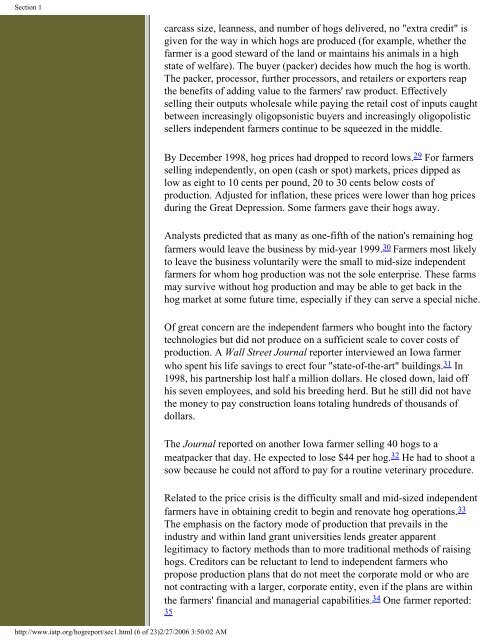IATP Hog Report - Institute for Agriculture and Trade Policy
IATP Hog Report - Institute for Agriculture and Trade Policy
IATP Hog Report - Institute for Agriculture and Trade Policy
Create successful ePaper yourself
Turn your PDF publications into a flip-book with our unique Google optimized e-Paper software.
Section 1<br />
carcass size, leanness, <strong>and</strong> number of hogs delivered, no "extra credit" is<br />
given <strong>for</strong> the way in which hogs are produced (<strong>for</strong> example, whether the<br />
farmer is a good steward of the l<strong>and</strong> or maintains his animals in a high<br />
state of welfare). The buyer (packer) decides how much the hog is worth.<br />
The packer, processor, further processors, <strong>and</strong> retailers or exporters reap<br />
the benefits of adding value to the farmers' raw product. Effectively<br />
selling their outputs wholesale while paying the retail cost of inputs caught<br />
between increasingly oligopsonistic buyers <strong>and</strong> increasingly oligopolistic<br />
sellers independent farmers continue to be squeezed in the middle.<br />
http://www.iatp.org/hogreport/sec1.html (6 of 23)2/27/2006 3:50:02 AM<br />
By December 1998, hog prices had dropped to record lows. 29 For farmers<br />
selling independently, on open (cash or spot) markets, prices dipped as<br />
low as eight to 10 cents per pound, 20 to 30 cents below costs of<br />
production. Adjusted <strong>for</strong> inflation, these prices were lower than hog prices<br />
during the Great Depression. Some farmers gave their hogs away.<br />
Analysts predicted that as many as one-fifth of the nation's remaining hog<br />
farmers would leave the business by mid-year 1999. 30 Farmers most likely<br />
to leave the business voluntarily were the small to mid-size independent<br />
farmers <strong>for</strong> whom hog production was not the sole enterprise. These farms<br />
may survive without hog production <strong>and</strong> may be able to get back in the<br />
hog market at some future time, especially if they can serve a special niche.<br />
Of great concern are the independent farmers who bought into the factory<br />
technologies but did not produce on a sufficient scale to cover costs of<br />
production. A Wall Street Journal reporter interviewed an Iowa farmer<br />
who spent his life savings to erect four "state-of-the-art" buildings. 31 In<br />
1998, his partnership lost half a million dollars. He closed down, laid off<br />
his seven employees, <strong>and</strong> sold his breeding herd. But he still did not have<br />
the money to pay construction loans totaling hundreds of thous<strong>and</strong>s of<br />
dollars.<br />
The Journal reported on another Iowa farmer selling 40 hogs to a<br />
meatpacker that day. He expected to lose $44 per hog. 32 He had to shoot a<br />
sow because he could not af<strong>for</strong>d to pay <strong>for</strong> a routine veterinary procedure.<br />
Related to the price crisis is the difficulty small <strong>and</strong> mid-sized independent<br />
farmers have in obtaining credit to begin <strong>and</strong> renovate hog operations. 33<br />
The emphasis on the factory mode of production that prevails in the<br />
industry <strong>and</strong> within l<strong>and</strong> grant universities lends greater apparent<br />
legitimacy to factory methods than to more traditional methods of raising<br />
hogs. Creditors can be reluctant to lend to independent farmers who<br />
propose production plans that do not meet the corporate mold or who are<br />
not contracting with a larger, corporate entity, even if the plans are within<br />
the farmers' financial <strong>and</strong> managerial capabilities. 34 One farmer reported:<br />
35

















